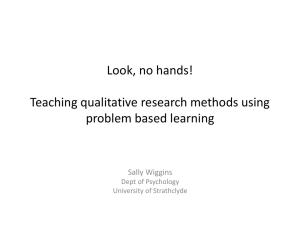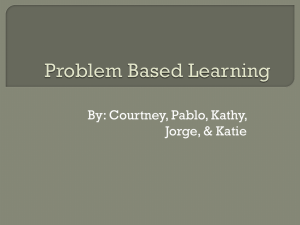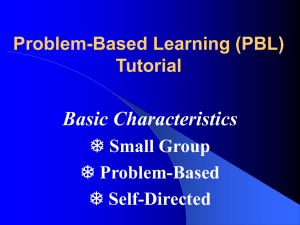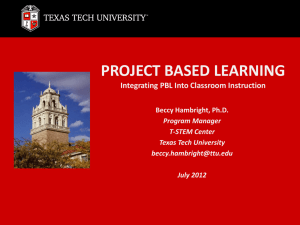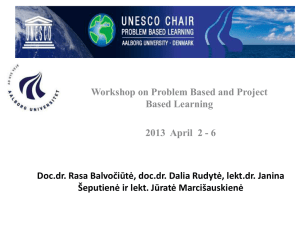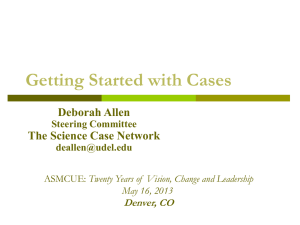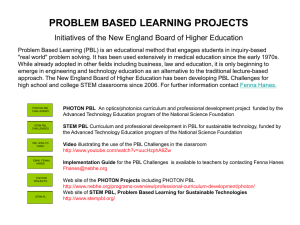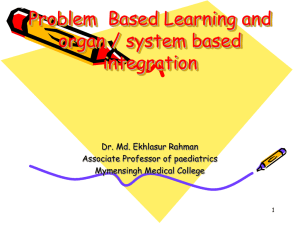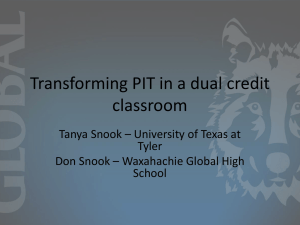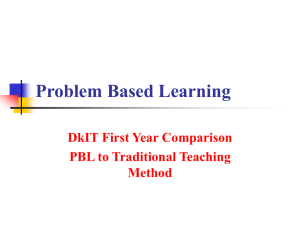Problem-Based Learning (PBL)
advertisement
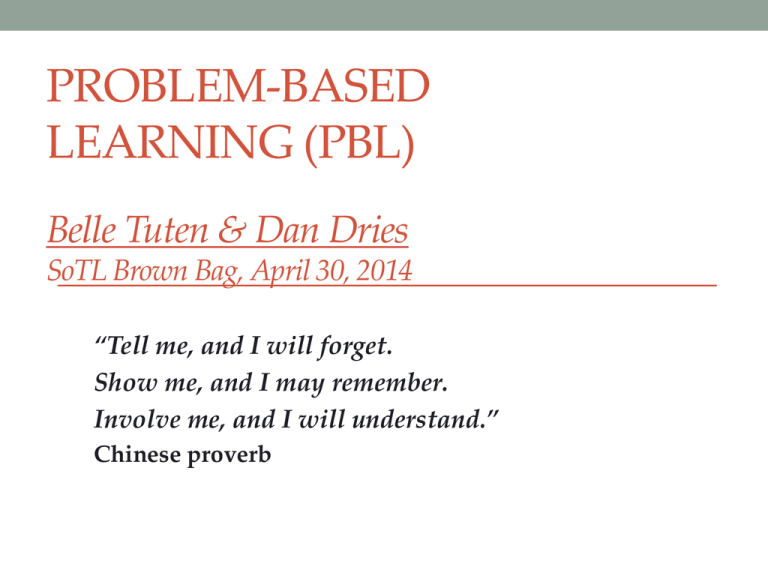
PROBLEM-BASED LEARNING (PBL) Belle Tuten & Dan Dries SoTL Brown Bag, April 30, 2014 “Tell me, and I will forget. Show me, and I may remember. Involve me, and I will understand.” Chinese proverb HOW DID WE GET INTO PBL AS A PEDAGOGY? What good is knowledge without curiosity? Problem-Based Learning (PBL): Rekindling Curiosity “Just because you covered it doesn’t mean you uncovered it.” – Hal White, Univ. of Delaware Exemplary Contributions to Education Award Lecture 2014 ASBMB National Meeting Problem-Based Learning (PBL): Rekindling Curiosity Glass of water with ice cube in it. As the ice cube melts, what will happen to the water level? • Rise? • Stay the same? • Fall? Problem-Based Learning (PBL): Rekindling Curiosity No textbook Uses the primary literature • Authentic, not contrived • Historical • Complex • Relevant • Requires/develops creative library/internet search skills “On the Reduction and Oxidation of the Colouring Matter of the Blood.” G. G. Stokes -Proc. of the Royal Society, London 13, 355-364 (1864) Some time ago my attention was called to a paper by Professor Hoppe, in which he has pointed out the remarkable spectrum produced by the absorption of light by a very dilute solution of blood, and applied the observation to elucidate the chemical nature of the colouring matter… I proceeded to try the effect of various reagents. The observation is perfectly simple, since nothing more is required than to place the solution to be tried, which may be contained in a test-tube, behind a slit, and view it through a prism applied to the eye. In this way it is easy to verify Hoppe's statement, that the colouring matter (as may be presumed at least from the retention of its peculiar spectrum) is unaffected by alkaline carbonates and caustic ammonia, but is almost immediately decomposed by acids, and also, but more slowly, by caustic fixed alkalies, the coloured product of decomposition being the hæmatin of Lecanu, which is easily identified by its peculiar spectra. But it seemed to me to be a point of special interest to inquire whether we could imitate the change of colour of arterial into that of venous blood, on the supposition that it arises from reduction. PBL: Example #1-Dan • Spring 2015: Biochemistry and Molecular Biology (BMB) I • Sophomore • Enrollment ~70 • Two sections?: PBL vs. traditional lecture • Curare • Pilot: BMB III in Fall 2014 PBL: Example #2-Belle • See linked examples of work and the PBL packet Belle used for Medieval Medicine on the SoTL website PBL: Pros and Cons Advantages • Transferable skills • Deconstructing primary literature • Encourages ownership of education • Retention of material • Flexible curriculum • Group work • Different learning styles, viewpoints, strengths • Keeps instructor engaged with current material • Can interface with guest lecturer(s) Disadvantages • Content • Lack of breadth • Less structure • Pace • Requires self-motivation • Group work • Requires clear learning objectives • Requires careful choice of primary literature to maximize coverage PBL: Sample First module Day 1: Day 2: POGIL to prepare reading article Demonstration – ask for questions/ learning issues Scan article, then revisit and write learning issues Day 3: Discuss, assign learning issues Day 4: Debrief, revisit, re-examine learning issues Individual writing assignment distributed PBL: Sample First module Day 5: Day 6: Day 7: Day 8: Individual assignment due. Debrief, revisit, re-examine learning issues Demo or POGIL activity (interface with instructor-generated learning issues) In-class discussion of article (recap led by instructor) Group assignment: group answer to earlier individual assignment In-class quiz. Final discussion. PBL: Sample Grading Scheme 20% - Midterm* 30% - Final (comprehensive)* *Of which 25% comes from a group exercise. 40% - Individual and group assignments - 15% Individual writing assignment 10% - Attendance, preparation, participation, attitude - 5% self-evaluation - 5% group evaluation PBL: A Word about Group Work • Group composition • Peer tutor-facilitator (no hand in grading) • Random? Instructor-selected? Self- selected? • Rules, contracts, and autonomy • Instructor intervention • Roles: Recorder, Task Master, Skeptic, Technical Advisor, Fact-Finder • Assessment: Individual vs. Group Resources • Problem-Based Learning (PBL) at the University of Delaware (includes sample syllabi and problems, evaluation forms, videos) • CHEM-342: Introductory Biochemistry (Hal White, Univ. of Delaware) • Duch, Barbara J., et al. The Power of Problem-Based Learning: A Practical ‘How To’ for Teaching Undergraduate Courses in Any Discipline. Sterling, VA: Stylus Publishing, 2001. Print. • Dan Tries PBL (A 1996 case study of an anthropology professor trying to incorporate PBL into his class. Disclaimer: different Dan!) • Qualitative assessment on the incorporation of PBL into the UD curriculum • Belle maintains a Zotero group with literature on PBL. Please email Belle for an invitation.
